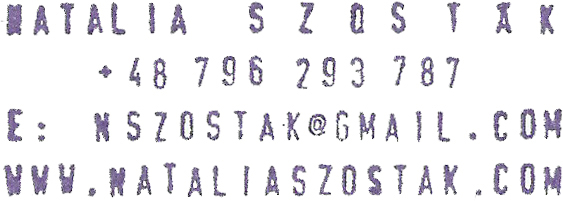|
|
|
|
|
|
Aleksandra Gieczys-Jurszo, In
the Trap of Subjectivity
At the first glimpse of an eye
her art stands out. The artist does not avoid topics connected with the
meaning of life, which are nowadays a real rarity among young artists.
Provocatively, she admits she has religious fascinations even though
she declares to be an atheist. Meet Natalia Szostak.
Your artistic activity works
really well in spheres where a need to show own experience arises,
either emotional, sensual, spiritual or intellectual. In your works,
you redefine your way of existing in the world, you invite the audience
to take part in this private act. Aren't you afraid of being
misunderstood or even accused of being narcissistic?
What I do usually generates a series of reactions. This is how I
communicate with others. An indispensable distance is needed when a
particular piece seems to be unclear, indifferent or shocking for some,
and clear and important for others. Owing to this, I feel that it is a
living process, that a certain sphere of utterance exists which it
still being shaped.
Many artists exists as a topic
for their art. I have always been interested in how much, on the level of art, the record of our own life
is distorted by a certain dose of intentional manipulation, creation?
It is a temptation to re-create oneself exists, a temptation to steer
consciously one's moods and reactions which will be represented in the
exposition. Is there a way around it?
No, there isn't. This is a trap of subjectivism. Reality is a problem.
We are not able to show a single image which we could call the one and
only. This is what creation is all about. Being aware of this, I try to
get to myself the closest I can to realities that I exist in; to myself
perceived by me.
Looking at oneself from a
broader perspective owing to one's own work is a good starting point to
understand reality and one's role in it. Such an insight must become a
trampoline to painful search for the meaning of life...
Yes, it is a form of documenting what is difficult to describe. Through
my work I try to go in this direction. Sharing this with others is
essential to this process. It is only then when confrontation occurs
which is so needed in future work. As a result it becomes a certain
record of my experience which ultimately satisfies me.
You intertwine various realia in
spaces where you place your work which are to represent your viewpoint
(for example a white dress). Could you explain their meaning?
A dress plays a role of a relic, a remnant of an event of special
importance. I use is as a symbol which refers to concrete experiences
which I cannot relate in words. It's more of a question mark than an
answer. It's an "evoker" of certain associations which in my works get
activated in various ways. There are more similar realia. I try to ease
emotions, which they evoke in me, via my work. I am not for making my
emotions more specific; it's rather making the visual lexicon bigger.
In the series "Miejsca
Poświęceń" / "Places of Sacrifice", you explored issues connected with the
construction of human identity. To get to the bottom of what makes a
human as an autonomous, unique and independent being, you had to go on
an ethnographic journey inside yourself.
"Miejsca Poświęceń" / "Places of Sacrifice"
consists
of images constructed to resemble an altar (a table used to
make sacrifices where offerings are to win God's favour). I use this
symbolism in the context of my own history, which is disordered and
chaotic. It distorts integrity of my own identity. The lack of clearly
sets a goal and sense of past events are contrasted with ordered form,
which gives them a new meaning. I systematize the past so that it
becomes clear but still I do not take its ambiguity away.
Your personal experience is
connected with living in many countries which became a starting point
for totally new perception. The perspective, presented by you, creates
a both private and public universal space for reflection. You show how
the process of creating one's subjectivity is conditioned by culture,
tradition and socializing processes.
That's true. Frequent changes of location, making the notion of "home"
more relative, progressive feeling of extirpation shape my view of the
world. The value system of one environment which is not adapted to a
new one gets devalued. We are forced to their mock-ups in a new place.
We look for substitutes. Often being unaware, we give away essential
elements building up our past
identity, we lose the feeling of self and move like children in the
fog. Contradictions created in the clash with changing reality make it
impossible to have a smooth transition. As a result, some things from
the outside become more vivid.
What are you working on at the
moment?
Slowly I am trying to abandon the "Places of Sacrifice" series. I am
focusing on self-portrait. I am in the middle of creating a new series
of anatomic self-portraits. Drawings and oils will be made on the basis
of these. Next year I want to use them in a new project located
somewhere in the city space.
|

